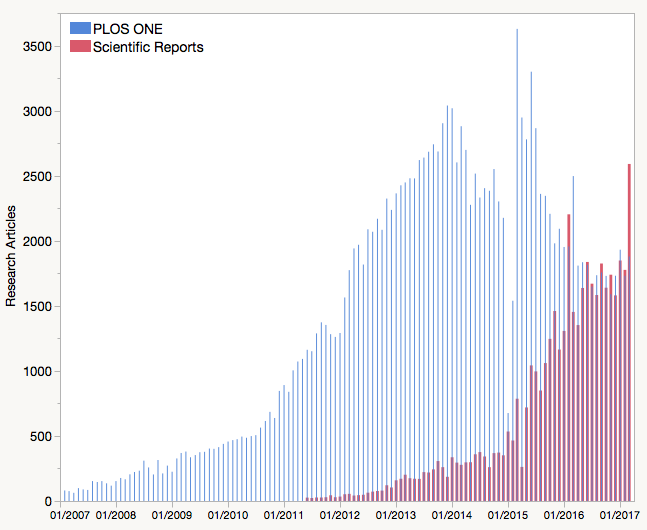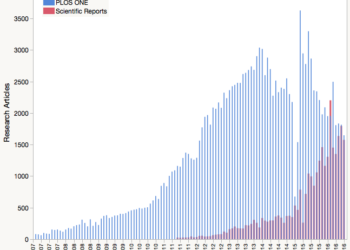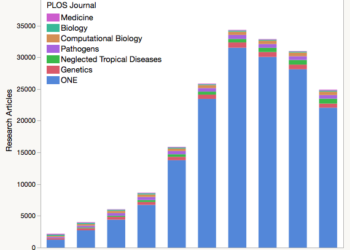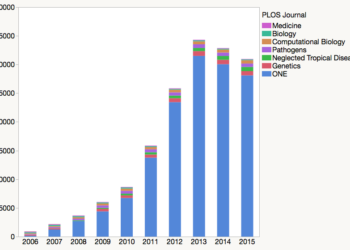After ten years of publishing, PLOS ONE is no longer the largest journal in the world.
That title is now held by Scientific Reports (Springer Nature), which published a total of 6,214 research articles in the first quarter of 2017, compared to 5,541 articles in PLOS ONE.

This should not come as a surprise to those following the scientific publications market. Indeed, I made this prediction last August. Output in PLOS ONE has been dropping since its peak in 2013.
The journal’s shrinkage is attributed, in part, to a reduction in manuscript submissions, explained Joerg Heber, PLOS ONE‘s newly instated Editor-in-Chief in a blog post celebrating the ten-year anniversary of the journal. In an interview with Retraction Watch, Heber also noted that the journal has lowered its acceptance rate:
Part of the reduced output is explained by a lower acceptance rate, which now stands at around 50%. This is lower than in the past, but we have not altered our editorial bar and remain fully committed to our mission of publishing all solid research independent of impact.
Heber further speculates that part of the drop in submissions might be explained by competing journals that are based on the same editorial model, meaning, journals like Scientific Reports.
Scientific Reports and PLOS ONE are remarkably similar. Yet, Scientific Reports has a much higher Impact Factor (5.228 vs. 3.057), shorter publication delay, and more lenient data availability policies — characteristics that may be drawing potential authors from PLOS ONE.
While most editors would view a decline in submissions and output as unwelcome news, Heber is upbeat about the broader meaning of PLOS ONE‘s decline.
This overall is great news for the research community as it means more Open Access research being published without barriers based on subjective criteria of relevance.
Is this great news? From a mission standpoint, it is perhaps the clearest sign of the enormous impact that PLOS ONE has had on the marketplace and the success of the megajournal model.
From a business standpoint, however, ceding this market to a commercial competitor harms PLOS’ future prospects. Unlike most large publishers, PLOS relies almost entirely on article processing charges (APCs) for revenue, leaving it highly vulnerable to shifts in author behavior. Net revenue at the not-for-profit has been falling in recent years, from over $10 Million in 2013, to nearly $5M in 2014, to just $0.5M in 2015. The decline in PLOS ONE output is expected to deprive the publisher of an additional $9M in revenue for 2016. Since revenue from PLOS ONE serves to support six other PLOS journals, a decline in APCs puts these titles at existential risk.
This speaks to the current state of the open access movement. The battle has, in many ways, been won, but the end result—the co-opting of OA by commercial publishers—looks very different from original expectations. If PLOS ONE’s marketshare continues to erode, it may prove difficult for them to continue to offer the bold experimentation that has driven so much progress.
Discussion
12 Thoughts on "Scientific Reports Overtakes PLOS ONE As Largest Megajournal"
Good points Phil. An alternative maybe that PLOS will seek to sell itself to someone who is seeking a megajournal. Springer has Scientific Reports but other major commercial publishers do not have a competing mega journal in their mix. Who knows maybe another spate of mergers will emerge.
Interesting that the acceptance rate is declining while editorial standards remain unchanged. Does that imply that the average quality of the declining number of submissions is itself declining?
Journal publishing equivalent of Godzilla vs Mothra. Kudos to Springer Nature.
This post also highlights the fragile economic foundations of the open access model that might need to hybridize its format or make efforts to create a self-propelling ecology of interrelated initiatives that could sustain its momentum. As an author at the openscience.com blog, I am not a stranger to how open access book and journal publishing works. My impression is that the open access model is beset by false antinomies between the no-fees ideals of free access and paywall or author-pays approaches that as the example of PLOS ONE incidentally shows collapse under the weight of reality.
Let’s see the final result by the end of 2017. This is very interesting competition indeed. I endorse the SpringerNature decision to discontinued the SpringerPlus journal in 2016 and making all the focus to 1 mega-journal (Scientific Reports).
Phil, I would like to know your opinion in Elsevier mega-journal (Heliyon), can this journal enter the competition between PLOS ONE & Scientific Reports in the future?
Phil, do you have a sense of how many papers are directly submitted to Scientific Reports vs transfers from within the Nature Portfolio? Direct submissions should be more readily comparable with PLOS ONE performance, I would think.
I am in interested in developments in social sciences. I have published in Sage Open which seems fine, and its prices have risen from $0 to $395. Heliyon is published by Elsevier (still subject to some boycotting since the Cost of Knowledge campaign), and it has only 14 social science papers published at $1,250. Palgrave Communications (Nature group) costs $1,200 and seems to be fairly new. Cogent Social Sciences is published by T&F, and you pay what you can, up to about the same as those other publishers (https://www.cogentoa.com/journal/social-sciences). Springerplus has gone. Collabra, the heralded UCal Press megajournal, seems to have morphed into Collabra-Psychology only ($875). There are a few dubious ones of the sort that appeared on Beall’s list. The idea of a social science megajournal has not taken off, I think. Sage Open seems successful, perhaps because the APC is reasonable and social sciences/humanities generally have less ability to pay from grants. Thoughts?
There was a recent blog-format review of APCs in the context of Open Access publishers that has garnered an extensive discussion in the social media and quite a few comments on its results and methodology: http://openscience.com/how-much-do-top-publishers-charge-for-open-access/.



